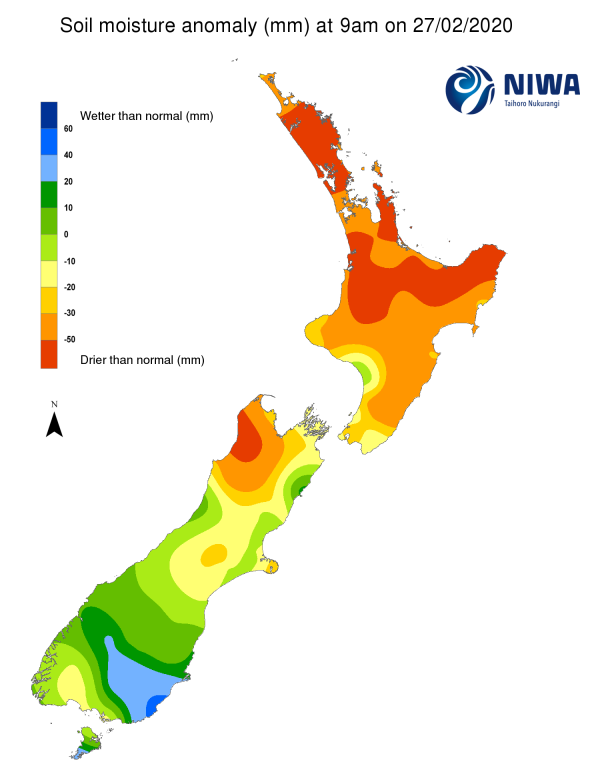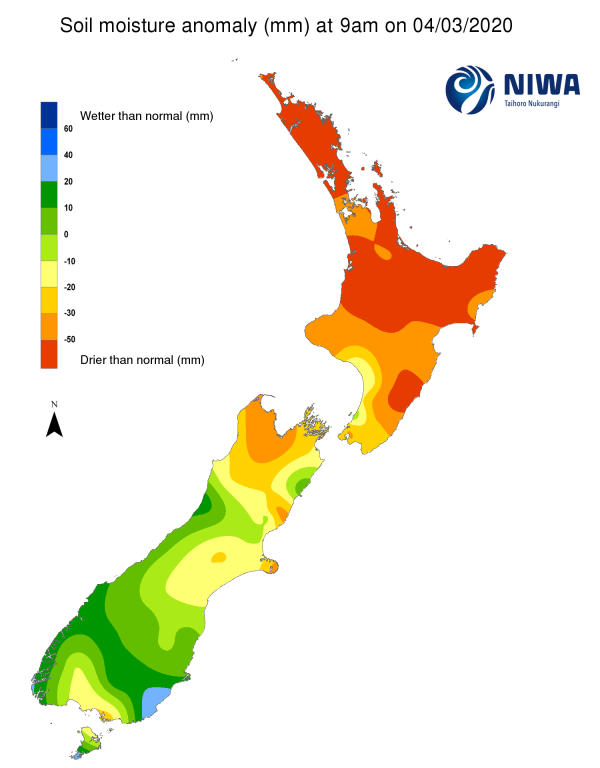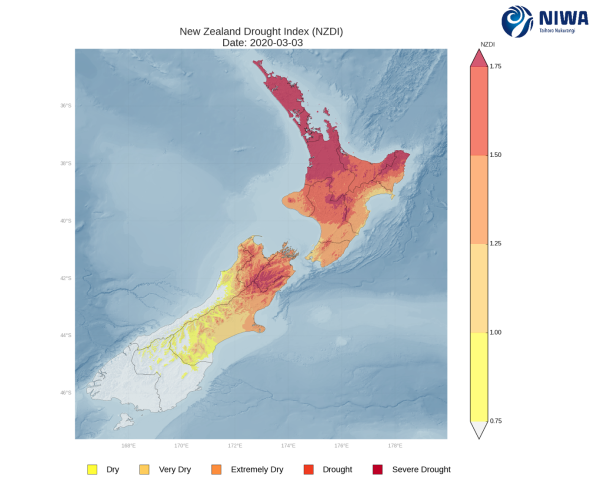A weekly update describing soil moisture patterns across the country to show where dry to extremely dry conditions are occurring or imminent. Regions experiencing significant soil moisture deficits are deemed “hotspots”. Persistent hotspot regions have the potential to develop into drought.
Facts: Soil Moisture
Across the North Island, rainfall during the past week was generally higher than several previous weeks, with many locations receiving 10-20 mm and isolated pockets of 30 mm or more. Despite this, soil moisture levels generally decreased slightly during the past week, particularly in the Far North and from Waikato to Hawke’s Bay. The driest soils across the North Island, when compared to normal for this time of the year, are generally found in the northern half of the island along with Wairarapa, while the wettest soils for this time of the year are located in Kapiti Coast. The New Zealand Drought Index (NZDI) shows that severe meteorological drought currently encompasses Northland, Auckland, much of Waikato, western Bay of Plenty, East Cape, and portions of interior Manawatu-Whanganui, with meteorological drought in place from Bay of Plenty to Taranaki (see NZDI map at bottom).
Nearly all of the North Island continues in official hotspot status, with only interior Taranaki and Kapiti Coast falling below hotspot thresholds.
In the South Island, the past seven days brought heavy rain to much of the West Coast, with widespread amounts of 75 mm or more. However, rainfall was generally meagre east of the Southern Alps, with many locations seeing less than 15 mm. The driest soils in the South Island compared to normal for this time of the year are located in Nelson, Tasman, and Banks Peninsula, while the wettest soils for this time of the year are found in coastal Clutha District. The New Zealand Drought Index (NZDI) shows that severe meteorological drought is now found in southern Marlborough (see NZDI map at bottom).
Current hotspots in the South Island now include Nelson and nearby parts of Tasman and Marlborough, coastal Hurunui, and Banks Peninsula.
Outlook and Soil Moisture
In the North Island, high pressure will be in control through the upcoming weekend (7-8 March), leading to dry weather nearly everywhere. The only exceptions are Gisborne and Hawke’s Bay, where an onshore wind flow will produce scattered showers. From early to mid next week, a weak front and decaying low pressure will bring scattered showers and possibly a few thunderstorms to much of the North Island, although total rainfall amounts are likely to be less than 15 mm for most locations. Weekly rainfall totals in Gisborne and Hawke’s Bay could reach 20-30 mm, however.
Although rainfall amounts in the next week are likely to be higher than recent weeks for many parts of the North Island, significant soil moisture increases are not expected. While a few areas may see small improvements (best chance along the east coast), other locations that miss out on locally heavy showers could in fact see small soil moisture decreases during the next seven days.
In the South Island, high pressure will result in dry weather through Saturday (7 March). However, low pressure in the Tasman Sea will bring moderate to heavy rain to much of the West Coast beginning on Sunday, with moderate rain also possible in Southland and Stewart Island. While rainfall from this event will be minimal in the eastern South Island, a developing southerly air flow by midweek will bring a few showers and possibly isolated thunderstorms to Otago and Canterbury. Weekly rainfall totals could exceed 60 mm in much of the West Coast, 25-35 mm in Southland and Otago, but only 5-15 mm in the rest of the eastern South Island.
Soil moisture levels may continue to decrease in the upper and eastern South Island during the next week, which may result in an expansion of current hotspots in these areas. Conversely, soil moisture levels could increase at least slightly along the West Coast and in the lower South Island.
Background:
Hotspot Watch: a weekly advisory service for New Zealand media. It provides soil moisture and precipitation measurements around the country to help assess whether extremely dry conditions are imminent.
Soil moisture deficit: the amount of water needed to bring the soil moisture content back to field capacity, which is the maximum amount of water the soil can hold.
Soil moisture anomaly: the difference between the historical normal soil moisture deficit (or surplus) for a given time of year and actual soil moisture deficits.
Definitions: “Extremely” and “severely” dry soils are based on a combination of the current soil moisture status and the difference from normal soil moisture (see soil moisture maps)
Hotspot: A hotspot is declared if soils are "severely drier than normal" which occurs when Soil Moisture Deficit (SMD) is less than -110 mm AND the Soil Moisture Anomaly is less than -20 mm.
Pictured above: Soil Moisture Anomaly Maps, relative to this time of year. The maps show soil moisture anomaly for the past two weeks.
New Zealand Drought Index (NZDI)
As of 3 March, the New Zealand Drought Index (NZDI) map below shows that all of the upper North Island is experiencing severe meteorological drought, along with East Cape and interior Manawatu-Whanganui, with meteorological drought in many other locations. In the South Island, meteorological and severe meteorological drought are now found in much of Marlborough and northern Canterbury.
Please note: some hotspots in the text above may not correspond with the NZDI map. This difference exists because the NZDI uses additional dryness indices, including one which integrates the rainfall deficit over the past 60 days. Changes are therefore slower to appear in the NZDI compared to soil moisture anomaly maps that are instantaneously updated.




